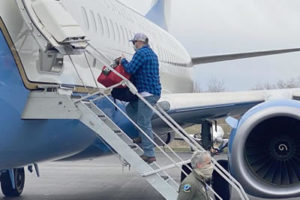
Matt Hamel of VA Maine Healthcare System boards a plane for a flight from Portland, Maine, to New York City, for a 14-day deployment to support VA COVID-19 response operations. More than 120 healthcare providers from the VA New England Healthcare System deployed to New York City and the greater Boston area to help with the COVID-19 outbreak. Photo from VAntage Point.
WASHINGTON—Last month, VA facilities were engaged in the same juggling act as healthcare organizations across the country—continuing to deal with a pandemic that in some areas of the country was worsening, while moving forward with plans to ease restrictions elsewhere.
Less than two weeks after VA revealed its national reopening plan, a select group of VA facilities began the first phase, expanding services that had been shut down due to the pandemic.
In mid-May, VA reached a grim milestone—1,000 patient deaths from COVID-19. In addition, more than 30 VA staff members had died from the virus. But while the total number of veterans diagnosed with COVID-19 was growing, the number under active care at VA was decreasing.
VA had seen more than 12,000 total patients with COVID-19 since the start of the pandemic, but its number of active cases was just under 1,700 by May 21, with more than 10,000 patients in recovery.
Even before the numbers started to dip, VA leaders had begun planning for a “reopening.”
“A central planning solution for resuming regular operations makes no sense here, because some areas of the country will take longer to recover, while other areas have seen minimal cases,” explained VA Secretary Robert Wilkie upon releasing VA’s three-phase reopening plan. “That’s why we’re letting local conditions dictate our next steps.”
To progress through the three phases of reopening, facilities must meet certain gating criteria. Those include a 14-day downward trajectory of influenza-like illnesses reported as well as a 14-day downward trajectory of COVID-like symptom cases reported, not just at the facility but in the surrounding region. Facilities and the surrounding region must also see a downward trajectory of documented COVID-19 cases during that time or a downward trajectory of positive tests as a percent of the total. Hospitals will also need to be able to treat all the patients in their care and maintain a robust testing program for at-risk healthcare workers, which includes emerging antibody testing.
Once a facility meets those criteria, it can progress to Phase 1. During Phase 1, the facility will maintain all their ongoing mitigation activities, including telework whenever possible, but can also begin assessing how to permit elective procedures and resume some face-to-face visits that had been postponed.
If, after moving into Phase 1, the facility has no rebound in COVID-19 cases and can maintain another 14-day downward trajectory, it can move to Phase 2. During this phase, facilities would add more non-emergent procedures and services. They would also be able to conduct public-facing services at VBA regional offices, resume committal services and military honors at national cemeteries, and reopen Fisher Houses and the Hoptel Program that provides lodging for veterans seeking distant care.
In Phase 3, VA facilities will begin allowing visitors to hospitals, community living centers, and spinal cord injury and disorder units. Most VA employees will also return to work in this phase.
On May 18, the first VA facilities entered Phase 1. These “lead sites” were spread across the country, from Puget Sound in Washington State to Southern Arizona to West Palm Beach, FL.
“The lessons learned from these sites will help inform how other facilities plan for expanding services in their facilities,” VA declared in a statement.
VBA In-Person Appointments
In late May, VA also announced it would resume in-person Compensation and Pension exams in concert with the reopening of some VAMCs around the country. VBA contracted medical examination providers will immediately begin contacting veterans in select locations with claims pending C&P exams to schedule exam appointments.
“Resuming C&P exams allows VA to continue delivering the benefits our Veterans have earned,” Wilkie said. “We’re keeping the safety of Veterans and our medical providers as our highest priority and have put a robust set of measures in place to ensure medical providers can safely conduct these examinations.”
Safety measures include COVID-19 screening for veterans and employees, physical distancing and appropriate personal protective equipment to include face coverings and gloves.
In-person exams are scheduled to begin within the next few weeks at VAMCs in the following locations: White River Junction, VT; Syracuse, NY; Erie, PA; Huntington, WV; Salem, VA; Charleston, SC; West Palm Beach, FL; Johnson City, TN; Cleveland; West Palm Beach, FL; Tomah, WI; Madison, WI; Kansas City, MO: Little Rock, AR; San Antonio; Fort Harrison, MT; Boise, ID; Seattle, WA; Las Vegas, NV; and Fargo, ND.
Veterans outside of these service areas will continue to be served through telehealth appointments or the acceptable clinical evidence process, according to VA officials, who also said that those not yet comfortable with an in-person interview will be able to make other arrangements.


